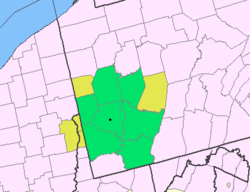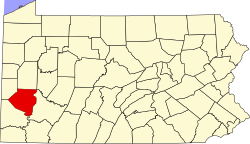Bruceton, Pennsylvania | |
|---|---|
 Dedication of the Experimental Mine, 1910 | |
 | |
| Coordinates: 40°18′17″N79°58′53″W / 40.30472°N 79.98139°W | |
| Country | United States |
| State | Pennsylvania |
| County | Allegheny |
| Borough/Township | Jefferson Hills, South Park |
| Elevation | 961 ft (293 m) |
| Time zone | UTC-5 (EST) |
| • Summer (DST) | UTC-4 (EDT) |
Bruceton is an suburban area of Greater Pittsburgh within Allegheny County, Pennsylvania. [1] While not an incorporated entity itself, its western half is part of South Park Township and its eastern half is part of Jefferson Hills.
Contents
Bruceton is the home of the Experimental Mine of the U.S. Bureau of Mines, which originally opened in 1910. [2] [3] It is also the home of the Pittsburgh Safety and Health Technology Center. The Pittsburgh and West Virginia Railway connected to the B&O Railroad in Bruceton. It is 185 miles (or 298 km) northwest of Washington D.C.[ citation needed ]

